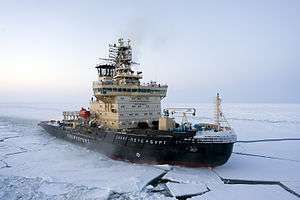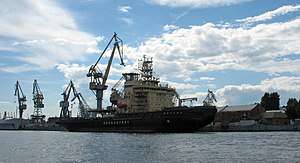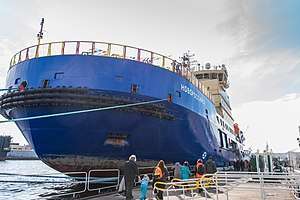Project 21900 icebreaker
Project 21900 icebreakers and their derivative designs are a series of Russian diesel-electric icebreakers built in the 2000s. They are also sometimes referred to using the type size series designation LK-16.[note 1]
 Sankt-Peterburg, the second Project 21900 icebreaker, underway in Kara Sea in 2015 | |
| Class overview | |
|---|---|
| Builders: |
|
| Operators: | Rosmorport |
| Built: |
|
| Planned: | 7 |
| Completed: | 5 |
| General characteristics | |
| Type: | Icebreaker |
| Displacement: | 14,300 t (14,100 long tons) |
| Length: | 114–119.8 m (374–393 ft) (overall) |
| Beam: | 27.5 m (90 ft) |
| Draft: | 8.5 m (28 ft) (design) |
| Ice class: | RMRS Icebreaker6 |
| Installed power: | Four diesel generating sets |
| Propulsion: | Diesel-electric; two Steerprop azimuth thrusters (2 × 8.2–9 MW) |
| Speed: |
|
| Crew: | 25 |
| Aviation facilities: | Helideck for Ka-32/Ka-226 (21900) or Mi-8 (21900M) |
The two Project 21900 icebreakers built by Baltic Shipyard, Moskva and Sankt-Peterburg, were the first non-nuclear icebreakers built by a Russian shipyard in over three decades and the first new icebreakers ordered following the dissolution of the Soviet Union. Few years later, three additional icebreakers of a slightly improved design referred to as Project 21900M were ordered from Vyborg Shipyard: two vessels (Vladivostok and Novorossiysk) were built in Russia and the third (Murmansk) was subcontracted to the Finnish shipbuilder Arctech Helsinki Shipyard. In 2019, one icebreaker of revised Project 21900M2 design was ordered from Pella Sietas.
Development and construction
Project 21900
In the early 2000s, Russia's state-owned icebreaker fleet consisted mainly of Soviet-era vessels dating back to the 1970s and 1980s.[1] Whereas the Soviet Union had been steadily building up the world's largest icebreaker fleet, Russia had managed to commission only one nuclear-powered icebreaker during the decade following its dissolution. In addition, the construction of another nuclear-powered icebreaker had been suspended in the mid-1990s due to lack of funds[2] and a number of older diesel-powered icebreakers were written off in the 1990s.[3]
Despite efforts to extend the service life of the deteriorating Soviet-era icebreaker fleet and a number of private Russian companies acquiring their own icebreaking vessels to serve their needs, a fleet renewal plan was direly needed to avoid a situation where older icebreakers would be decommissioned before their replacements were ready.[1] As a result, the federal program Modernization of the transport system of Russia (2002–2010) included recapitalizing the icebreaker fleet with a number of new vessels. Among these were two medium-sized diesel-electric icebreakers for service in the Gulf of Finland and Saint Petersburg area.[4]
In July 2004, the Saint Petersburg-based Baltic Shipyard won an international tender for the construction of two 16-megawatt diesel-electric icebreakers for Rosmorport, a state-owned company established in 2003 to manage Russia's port infrastructure and operate its fleet of diesel-powered icebreakers. The other bidders for the $150 million contract included the Finnish shipbuilders Kvaerner Masa-Yards and Aker Finnyards that had previously built a large number of icebreakers for the Soviet Union.[5] Although Baltic Shipyard had built five Arktika-class nuclear-powered icebreakers in 1975–1992 and had the sixth under construction at the time, these would be the first non-nuclear icebreakers built on a Russian shipyard in over three decades and the first new icebreakers ordered following the dissolution of the Soviet Union.[6] While the state budget did not initially allocate funding for the new icebreakers, the construction was nonetheless set to begin already in 2004 and the lead ship was to be delivered by November 2006.[5]
The lead ship of Project 21900 icebreakers, Moskva, was delivered on 11 December 2008 and the sister ship, Sankt-Peterburg, on 12 July 2009.[7][8]
Project 21900M
Following the challenging winter navigating season of 2010–2011, during which ice conditions in the Baltic Sea became so severe that Russia was forced to call in the nuclear-powered icebreaker Vaygach from Murmansk to escort ships in the eastern Gulf of Finland,[9] the Russian government decided to continue the fleet renewal within the framework of the federal program Development of the Transport System of Russia (2010–2020) with three additional 16-megawatt diesel-electric icebreakers.[1][10] While the initial agreement was signed between Rosmorport and the state-owned United Shipbuilding Corporation (USC) at the Baltic Shipyard, the construction of the first icebreaker awarded to the non-USC-affiliated Vyborg Shipyard on 2 December 2011.[11][12] On 23 February 2012, the remaining two vessels were also contracted to Vyborg Shipyard which was simultaneously acquired by USC to solve the shipyard's financial problems.[13][14] Hull assembly, outfitting and commissioning of one icebreaker was subcontracted to the Finnish shipbuilding company Arctech Helsinki Shipyard which, at the time, was a joint venture between USC and a subsidiary of the South Korean STX Offshore & Shipbuilding.[15]
The new icebreakers, referred to as Project 21900M, represented a further development of the preceding design.[1] The lead ship, Vladivostok, was delivered by Vyborg Shipyard on 23 September 2015.[16] She was followed by the Arctech-built Murmansk on 25 December 2015[17] and the final vessel of the series, Novorossiysk, on 26 December 2016.[18]
Project 21900M2
In April 2019, Rosmorport contracted Vympel Design Bureau to develop a new 18-megawatt icebreaker concept based on the previous Project 21900M design. The new icebreaker, named Project 21900M2, would feature selective catalytic reduction (SCR) units and scrubbers to reduce nitrogen oxide (NOx) and sulfur oxide (SOx) emissions, respectively, as well as meet the requirements of the International Code for Ships Operating in Polar Waters (Polar Code).[19][20]
In August 2019, Rosmorport opened a RUB 7,549,241,400 (about 100 million euro) tender for the construction of a 18-megawatt icebreaker to ensure year-round operation of the Russian Far East. According to the tender, the new icebreaker would be delivered by 30 September 2024.[21] On 5 September 2019, it was announced that the contract was awarded to the Otradnoye-based Pella Shipyard which was the only bidder.[22] However, construction of the vessel has been subcontracted to Pella Sietas in Hamburg, Germany, for which the 100 million euro order is the biggest single contract in the company history.[23]
On 2 April 2020, Rosmorport opened a second tender for a similar icebreaker to be constructed for the Baltic Sea with delivery by 10 December 2024.[24] However, the Russian newspaper Kommersant speculated that the contract price (RUB 7,309,329,900; about 85 million euro in April 2020) may be too low to attract bidders for a vessel with foreign-sourced components due to the volatility of the Russian ruble.[25] The tender was extended by two weeks in late April and finally declared invalid on 12 May after no bids had been submitted for the construction of the new icebreaker.[26][27]
Design
Project 21900 icebreakers are 114 metres (374 ft) long overall and have a moulded beam of 27.5 metres (90 ft). Fully laden, the 14,300-tonne (14,100-long-ton) icebreakers draw 8.5 metres (28 ft) of water.[28] While Project 21900M icebreakers are slightly longer at 119.8 metres (393 ft), they have the same beam, design draught and displacement.[29] The general layout of both designs is somewhat similar with the largest external difference being the helideck: Project 21900 icebreakers have a slightly smaller landing area located behind the superstructure while in Project 21900M and 21900M2 icebreakers the helideck has been moved to the forecastle and increased in size.[30]
Both Project 21900 and 21900M icebreakers have a fully integrated diesel-electric propulsion system with four main diesel generators supplying power for both main propulsion as well as the ship's service loads while underway. In the first two vessels, the main power plant consists of two 4,500-kilowatt (6,000 hp) 9-cylinder Wärtsilä 9L32 and two 6,000-kilowatt (8,000 hp) 12-cylinder Wärtsilä 12V32 medium-speed diesel engines.[28] In the three following vessels, all four main engines are identical 12-cylinder Wärtsilä 12V32E units rated at 6,960 kilowatts (9,330 hp) each.[29] In addition, all icebreakers have two Wärtsilä 4L20 auxiliary diesel generators for use when the vessel is at port.[30][31]
For main propulsion, both Project 21900 and 21900M icebreakers are fitted with two electrically driven Steerprop Z-drive azimuth thrusters with four-bladed stainless steel propellers. In the first two vessels, the propellers were in pusher configuration whereas the later icebreakers had more efficient forward-facing propellers. Each propeller is driven by two electric propulsion motors in tandem: in Project 21900, they are rated at 4,100 kW (5,500 hp) each while in Project 21900M the motors have been uprated to 4,500-kilowatt (6,000 hp). The resulting combined propulsion power output is about 16,000 kilowatts (21,000 hp) (21900) to 18,000 kilowatts (24,000 hp) (21900M). In addition, the icebreakers have a single transverse bow thruster for maneuvering.[28][29][30]
Project 21900 icebreakers are strengthened to Russian Maritime Register of Shipping ice class Icebreaker6 which is intended for icebreaking operations in non-Arctic freezing seas where the ice is up to 1.5 metres (5 ft) thick.[28] While officially the Project 21900M icebreakers have the same ice class,[29] their hulls and propulsion systems are strengthened to meet the requirements of Icebreaker7 which is a higher ice class intended for icebreaking operations in the Arctic.[32][33]
Ships in class
| Name | Project | Builder | IMO number | Built | Status | Image | Ref |
|---|---|---|---|---|---|---|---|
| Moskva | 21900 | Baltic Shipyard (Saint Petersburg, Russia) | 9326574 | 2008 | In service |  |
[28] |
| Sankt-Peterburg | 21900 | Baltic Shipyard (Saint Petersburg, Russia) | 9326586 | 2009 | In service | .jpg) |
[34] |
| Vladivostok | 21900M | Vyborg Shipyard (Vyborg, Russia) | 9658654 | 2015 | In service | [35] | |
| Murmansk | 21900M | Arctech Helsinki Shipyard (Helsinki, Finland) | 9658666 | 2015 | In service | .jpg) |
[36] |
| Novorossiysk | 21900M | Vyborg Shipyard (Vyborg, Russia) | 9692571 | 2016 | In service |  |
[37] |
| 21900M2 | Pella Sietas (Hamburg, Germany) | 9901374 | 2023 (planned) | Ordered | [23] | ||
| 21900M2 | 2024 (planned) | Planned | [24] |
Notes
- The type size series designation "LK-16" (Russian: ЛК-16) comes from the Russian language word for "icebreaker" (Russian: ледокол, romanized: ledokol) and the propulsion power (16 megawatts).
References
- "Ломая лед" (PDF), ОСК (in Russian), 4 (8): 24, 2011, retrieved 20 May 2019
- Savelyev, Igor. "Nuclear giant goes out to the Northern Sea route". Maritime Market. Retrieved 20 May 2019.
- Les Défis Pour la Société Européenne À L'aube de L'an 2000: Stratégies Pour Un Développement Durable Des Etats Du Nord de L'Europe, Council of Europe, 1998, p. 94, retrieved 20 May 2019
- "Федеральная целевая программа "Модернизация транспортной системы России (2002-2010 годы)"" (in Russian). Russian Government. 5 December 2011. Retrieved 20 May 2019.
- "Для Приморска построят ледоколы" (in Russian). dp.ru. 21 October 2004. Retrieved 20 May 2019.
- "RosMorPort takes delivery of diesel-electric icebreaker Moskva built by Baltiysky Zavod". PortNews. 11 December 2008. Retrieved 19 May 2019.
- "The Moskva to serve St. Petersburg". PortNews. 12 December 2008. Retrieved 19 May 2019.
- "Владимир Путин на борту ледокола" (in Russian). RIA Novosti. 13 July 2009. Retrieved 9 June 2019.
- "Baltic Sea Icebreaking Sport 2010-2011" (PDF). Baltic Icebreaking Management. Retrieved 4 August 2019.
- "Подписан акт приема-передачи дизель-электрического ледокола «Владивосток» (фото)" (in Russian). PortNews. 9 October 2015. Retrieved 4 August 2019.
- "Vyborg Shipyard JSC will construct icebreaking vessel". Vyborg Shipyard. December 2012. Retrieved 4 August 2019.
- "Выборгский СЗ и ОСК подписали соглашение о строительстве дизельного ледокола мощностью 16 мВт" (in Russian). PortNews. 5 December 2011. Retrieved 20 May 2019.
- "The contract for construction of two diesel-powered open sea icebreakers has signed". Vyborg Shipyard. February 2012. Retrieved 20 May 2019.
- "ОСК спасает Выборгский завод" (in Russian). United Shipbuilding Corporation. 23 February 2012. Retrieved 4 August 2019.
- "Next icebreaker project 21900M will be built by Vyborg Shipyard in cooperation with Arctech Helsinki Shipyard". Vyborg Shipyard. December 2012. Retrieved 20 May 2019.
- "Official ceremony of lifting the National Flag on the prototype Icebreaker project 21900 M was held in St.-Petersburg". Vyborg Shipyard. September 2015. Retrieved 4 August 2019.
- "Icebreaker Murmansk project 21900M delivered to the customer at Vyborg Shipyard". Vyborg Shipyard. December 2015. Retrieved 4 August 2019.
- "Icebreaker Novorossiysk project 21900M delivered to the customer". Vyborg Shipyard. 27 December 2016. Retrieved 4 August 2019.
- "VDB to develop design of an 18MW icebreaker for Rosmorport". PortNews. 24 April 2019. Retrieved 17 August 2019.
- "Нижегородское КБ «Вымпел» спроектирует ледокол для «Росморпорта»" (in Russian). Tema NN. 15 May 2019. Retrieved 17 August 2019.
- "Росморпорт проводит конкурс на строительство ледокола мощностью 18 МВт для замерзающих морских портов Дальнего Востока" (in Russian). PortNews. 13 August 2019. Retrieved 17 August 2019.
- "Новый ледокол для "Росморпорта" построит СЗ "Пелла"" (in Russian). Sudostroenie.info. 5 September 2019. Retrieved 5 September 2019.
- "Pella Sietas GmbH secures construction of icebreaker of ice class "Icebreaker7" and largest single order in company history". Port of Hamburg. 9 December 2019. Retrieved 22 February 2020.
- "Росморпорт объявил конкурс на строительство ледокола мощностью 18 МВт с начальной ценой 7,3 млрд руб". PortNews. 2 April 2020. Retrieved 2 April 2020.
- "«Росморпорт» недооценил ледоколы" (in Russian). Kommersant. 2 April 2020. Retrieved 29 April 2020.
- "На постройку ледокола для "Росморпорта" за 7,3 млрд рублей не нашлось желающих" (in Russian). Sudostroenie.info. 29 April 2020. Retrieved 29 April 2020.
- "Конкурс на строительство второго ледокола 18 МВт для Росморпорта признан несостоявшимся" (in Russian). Sudostroenie.info. 14 May 2020. Retrieved 14 May 2020.
- "Moskva (050211)". Register of ships. Russian Maritime Register of Shipping. Retrieved 19 May 2019.
- "Vladivostok (120113)". Register of ships. Russian Maritime Register of Shipping. Retrieved 19 May 2019.
- ""Мурманск" для Петербурга: каков ледокол проекта 21900М?" (in Russian). Korabel.ru. 16 April 2018. Retrieved 19 May 2019.
- "Почти 4 млн рублей за запчасти к ледоколу «Москва» отдаст Росморпорт" (in Russian). Sudostroenie.info. 7 November 2014. Retrieved 9 June 2019.
- "Icebreaker of 21900M Project Hull Float Out Ceremony". Rosmorport. 29 April 2014. Retrieved 15 June 2019.
- "Rules for the Classification and Construction of Sea-Going Ships, Part I: Classification". Russian Maritime Register of Shipping. 2019. Retrieved 9 June 2019.
- "Sankt-Peterburg (060054)". Register of ships. Russian Maritime Register of Shipping. Retrieved 18 August 2019.
- "Vladivostok (120113)". Register of ships. Russian Maritime Register of Shipping. Retrieved 18 August 2019.
- "Murmansk (120132)". Register of ships. Russian Maritime Register of Shipping. Retrieved 18 August 2019.
- "Novorossiysk (120128)". Register of ships. Russian Maritime Register of Shipping. Retrieved 18 August 2019.